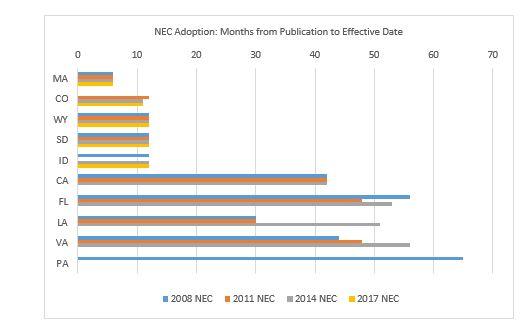by Brianna Crandall — May 11, 2018 — Across the United States, states vary widely in how promptly, or even if, they adopt the latest edition of NFPA 70: National Electrical Code (NEC), according to the National Fire Protection Association (NFPA). Not adhering to the latest edition can lead to serious shortfalls in electrical safety for citizens and a failure to protect first responders and workers from preventable dangers, adds the global nonprofit.
Underscoring these concerns is a new NFPA Fire & Life Safety Policy Institute report, Falling Behind on Electrical Safety, that includes a review of state practices and interviews with industry professionals.
According to NFPA, from 2010 to 2014, an annual average of more than 61,000 fires in the US were attributed to electrical failures or malfunctions, resulting in more than $2 billion in losses and claiming an average of 432 lives each year. Updates made to the National Electrical Code every three years help drive these numbers down by incorporating advances in knowledge and technology.
Examples of the changes include the requirement of using arc fault circuit interrupters (AFCIs), ground fault circuit interrupters (GFCIs) and tamper-resistant receptacles. Updates also include provisions to decrease the risk of dangerous arc flashes from high voltage electrical equipment, guidance for the installation of a wide variety of energy storage systems (ESS), and requirements for the rapid shutdown of photovoltaic (PV) systems to protect firefighters who may need to access locations charged with photovoltaics.
But with roughly a third of states skipping one or more NEC code updates and others amending the code to remove safety requirements, many homes, schools and businesses are not taking advantage of the advances in safety offered by each update and ultimately stall the fight against electrical fires and injuries, says NFPA.

The graph shows the length of time, in months, from publication of the updated version of the NEC to its effective date by state for the last four versions of the NEC. The five states at the top of the graph are the promptest adopters; the five states at the bottom are the slowest adopters. Graph courtesy NFPA
“The longer states wait to adopt, the longer they delay or fall behind in advancing electrical safety. This flatly goes against public expectations,” said NFPA Fire & Life Safety Policy Institute Director Meghan Housewright, referring to an earlier survey of US consumers showing more than 80 percent of US residents expect government to adopt and enforce up-to-date safety codes.
The new report by the Policy Institute found a number of factors that contribute to mismatched NEC adoption practices across the country. These include: greater political pressure and involvement from state legislators; increased scrutiny of regulatory activities; consideration only of cost without consideration of benefits; and less independence for appointed experts involved in code adoption activities.
Given these trends, the Policy Institute in its report is recommending state policymakers take advantage of the robust national process used to update the NEC. This process, according to Housewright, draws extensive, nationwide participation, is driven by consensus, and is governed to prevent dominance by any given interest group. States can and should rely on this process to advance safety without imposing unnecessary burdens on their constituents.
The Policy Institute also recommends that states:
- Rely on experts — To maintain a robust level of expertise that will enable timely adoption, states should rely on electrical regulatory boards to update the electrical code and implement statewide licensing for electricians. States with electrical boards are more efficient, tending to adopt new updates in about half the time as states that do not use an electrical regulatory board.
- Prioritize adoption of the NEC — The electrical code is just one of several nationally developed codes that impact construction such as codes for residential and commercial construction, energy conservation and plumbing. Waiting to adopt the NEC updates with other codes creates inevitable delays in advancing electrical safety and technology.
- Consider costs holistically and in context — Every year electrical-related fires are responsible for an average of more than $2 billion in direct property losses. Focusing solely on costs of compliance ignores the potential benefits of lives and dollars saved through the prevention of fire and accidents.
Director Housewright continued:
Policymakers can make the difference to ensure residents are safe in their homes and businesses, but the fact is, while some states do this well, many others do not. Governments should take steps to improve safety for the citizens they serve.
To see the report summary and NEC infographic, to read the Falling Behind on Electrical Safety report, or for further information and additional resources, visit the Policy Institute website.




